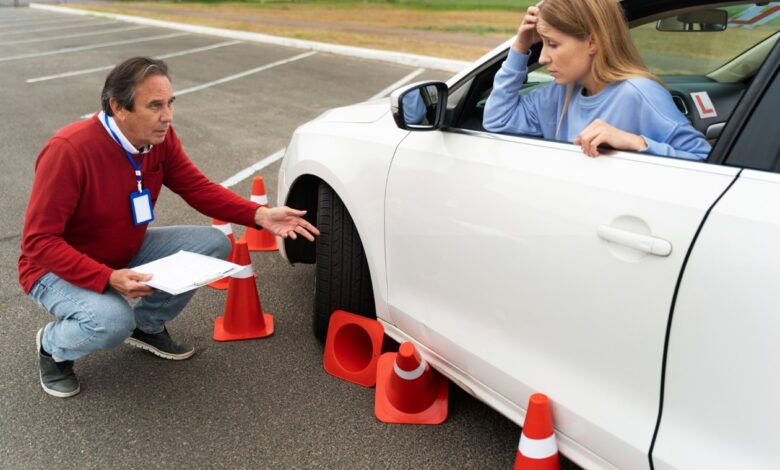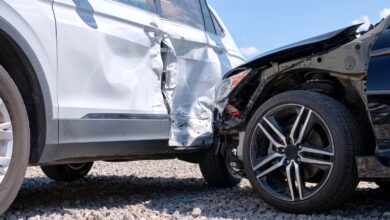Defensive Driving Techniques for Avoiding Common Traffic Accidents

In today’s fast-paced world, navigating through traffic can be a daunting task. The roads are filled with various challenges and potential hazards that can lead to accidents. Defensive driving is a crucial skill that every driver should possess to ensure their safety and the safety of others on the road. In this comprehensive guide, we will explore defensive driving techniques that can help you avoid common traffic accidents.
Defensive Driving Techniques
Defensive driving is more than just a set of skills; it’s a mindset that prioritizes safety on the road. It involves proactive measures and techniques to minimize the risk of accidents. Defensive drivers are vigilant, cautious, and always prepared for the unexpected.
Understanding the Importance of Defensive Driving
Defensive driving is not just a skill; it’s a mindset that can save lives on the road. It is of paramount importance in today’s world where the roadways are increasingly congested, and accidents are all too common. So, why is defensive driving so crucial?
Minimizing the Impact of Others’ Mistakes
One of the fundamental principles of defensive driving is recognizing that you can’t control the actions of other drivers. However, you can control your own reactions. Defensive driving empowers you to anticipate and react to the mistakes of others, reducing the likelihood of accidents caused by their errors.
Staying Prepared for the Unexpected
On the road, surprises are rarely pleasant. Defensive drivers are constantly vigilant and prepared for the unexpected. Whether it’s a sudden stop, a reckless lane change, or an unexpected obstacle, defensive driving equips you to handle these situations with confidence.
Read More: How to Save Money on Car Insurance in 2023
Prioritizing Safety Over Speed
In a world where everyone seems to be in a hurry, defensive driving emphasizes safety over speed. Speeding is a common cause of accidents, and defensive drivers adhere to speed limits and adjust their speed based on road conditions, traffic, and weather.
Avoiding Distracted Driving
Distracted driving is a pervasive problem with the rise of smartphones and other distractions. Defensive drivers prioritize staying focused on the road, resisting the urge to text, talk on the phone, or engage in other activities that divert their attention.
Proactive Risk Reduction
Defensive driving isn’t just about reacting to situations as they arise; it’s about proactively reducing risks. By maintaining a safe following distance, scanning the road ahead, and making well-informed decisions, defensive drivers actively work to prevent accidents.
Adapting to Adverse Conditions
Defensive driving includes the ability to adapt to adverse weather conditions. Rain, snow, fog, and other weather-related challenges require a different approach to driving, and defensive drivers are well-prepared for these situations.
Remaining Calm in the Face of Aggression
Aggressive drivers can be a menace on the road. Defensive drivers stay calm, avoid confrontations, and allow aggressive drivers to pass, reducing the risk of road rage incidents.
Continuous Improvement
Lastly, the importance of defensive driving lies in its commitment to continuous improvement. Defensive drivers are always looking for ways to enhance their skills, whether through defensive driving courses or self-assessment.
In conclusion, defensive driving isn’t just about obeying traffic rules; it’s a holistic approach to safe and responsible driving. By adopting a defensive driving mindset and practicing its principles, you not only protect yourself but also contribute to making the roads safer for everyone.
Maintaining Focus and Attention
Defensive Driving Techniques: Distracted driving is a leading cause of accidents. Defensive drivers prioritize staying focused on the road, avoiding activities such as texting, talking on the phone, or adjusting the radio while driving.
Anticipating Potential Hazards
Defensive Driving Techniques: A key aspect of defensive driving is anticipating potential hazards. This involves scanning the road ahead and being prepared for sudden stops, lane changes, or obstacles.
Keeping a Safe Following Distance
Defensive Driving Techniques: Maintaining a safe following distance is crucial. Defensive drivers leave enough space between their vehicle and the one in front to allow for sudden stops without collisions.
Managing Speed Effectively
Defensive Driving Techniques: Speeding is a common cause of accidents. Defensive drivers adhere to speed limits and adjust their speed based on road conditions, traffic, and weather.
Proper Vehicle Maintenance
Defensive Driving Techniques: Regular vehicle maintenance is essential for safety. Defensive drivers ensure that their brakes, tires, lights, and other critical components are in good working condition.
Avoiding Distractions
Modern life is filled with distractions, but defensive drivers resist the temptation to engage in distracting activities while driving.
Handling Adverse Weather Conditions
Defensive driving includes knowing how to navigate through rain, snow, fog, and other adverse weather conditions safely.
Dealing with Aggressive Drivers
Aggressive drivers can pose a significant threat. Defensive drivers stay calm, avoid confrontation, and allow aggressive drivers to pass.
Using Defensive Driving Courses
Enrolling in defensive driving courses can provide valuable insights and techniques to enhance your driving skills.
Avoiding DUI and Distracted Driving
Driving under the influence (DUI) and distracted driving are dangerous behaviors that defensive drivers always avoid.
Safe Lane Changing
Defensive Driving Techniques: Changing lanes requires careful observation and signaling. Defensive drivers make lane changes safely and efficiently.
Pedestrian and Cyclist Awareness: Sharing the Road Safely
In the world of traffic, it’s not just about vehicles. Pedestrians and cyclists are essential road users who deserve our attention and consideration. Being aware of and respecting their presence is a fundamental aspect of defensive driving.
The Vulnerability of Pedestrians and Cyclists
Pedestrians and cyclists are among the most vulnerable road users. Unlike drivers, they lack the protective shell of a vehicle. Understanding their vulnerability is the first step towards better awareness.
Follow Traffic Rules
Respecting traffic rules is essential when sharing the road with pedestrians and cyclists. Stop at crosswalks and give them the right of way when required. Obeying traffic signals is crucial to prevent accidents.
Maintain a Safe Distance
When driving near pedestrians and cyclists, always maintain a safe following distance. This provides you with enough reaction time in case they suddenly stop or change direction.
Use Your Mirrors
Frequently check your rearview and side mirrors to ensure you’re aware of any pedestrians or cyclists approaching from behind. Blind spots can be a danger to these road users.
Check Intersections Thoroughly
Intersections are often where pedestrians and cyclists are most vulnerable. Look both ways before turning, and double-check for anyone crossing the street.
Be Patient
Pedestrians and cyclists might not move as quickly as vehicles. Exercise patience when waiting for them to cross or maneuver, and avoid aggressive actions.
Use Your Horn Sparingly
Excessive horn honking can startle pedestrians and cyclists. Use your horn sparingly and only when necessary to alert them of your presence.
Respect Bike Lanes and Sidewalks
Bike lanes and sidewalks are designated spaces for cyclists and pedestrians, respectively. Avoid encroaching on these areas unless absolutely necessary.
Nighttime Awareness
Be particularly vigilant at night. Pedestrians and cyclists can be harder to spot in low-light conditions. Use your headlights and drive at reduced speeds.
Share the Road Campaigns
Stay informed about local “Share the Road” campaigns or initiatives in your area. These often provide valuable information on how to safely coexist with pedestrians and cyclists.
Educate Others
Spread awareness about the importance of sharing the road safely with pedestrians and cyclists. Encourage responsible driving practices among friends and family.
Defensive Driving Courses
Consider enrolling in defensive driving courses that specifically cover pedestrian and cyclist awareness. These courses can enhance your knowledge and skills.
Lead by Example
Set an example for other drivers by consistently following pedestrian and cyclist safety guidelines. Your actions can influence others to drive responsibly.
Report Reckless Behavior
If you witness reckless behavior by other drivers towards pedestrians or cyclists, consider reporting it to the appropriate authorities. Your report could help prevent accidents.
Stay Attentive
Above all, stay attentive. Avoid distractions and keep your focus on the road, especially in areas where pedestrians and cyclists are present.
Read More:Automotive Safety: A Comprehensive Guide
Conclusion
By adopting these defensive driving techniques and making them a part of your daily driving routine, you can significantly reduce the risk of common traffic accidents. Remember that safety should always be your top priority on the road.
In the hustle and bustle of our daily lives, the roadways often serve as the stage for countless interactions and encounters. Defensive driving, as we have explored in this comprehensive guide, is not just a set of skills; it’s a philosophy of safe and responsible driving that can make a world of difference.
The importance of defensive driving cannot be overstated. By adopting the principles of vigilance, anticipation, and responsibility, you become a guardian of your own safety and the safety of others on the road. Here’s a recap of why defensive driving matters:
FAQs
What is defensive driving, and why is it important?
Defensive driving is a set of skills and a mindset that prioritizes safety on the road by minimizing the risk of accidents caused by other drivers’ mistakes.
How can I avoid distractions while driving?
Avoid distractions by not using your phone, adjusting the radio, or engaging in other activities that take your attention away from the road.
What should I do in adverse weather conditions?
In adverse weather conditions, reduce your speed, increase following distance, and use headlights and windshield wipers as needed.
How can I deal with aggressive drivers?
Stay calm, avoid confrontation, and let aggressive drivers pass you if necessary.
Are defensive driving courses worth taking?
Yes, defensive driving courses provide valuable knowledge and techniques to enhance your driving skills and safety.












One Comment